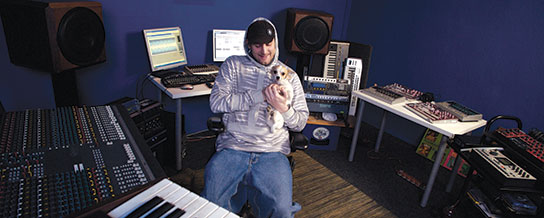Jay Haze in the Studio
In the world of digitally distributed singles being created, emailed to DJs, and ready for […]

Jay Haze in the Studio
In the world of digitally distributed singles being created, emailed to DJs, and ready for […]

In the world of digitally distributed singles being created, emailed to DJs, and ready for dancefloors before dinner time, Jay Haze’s Love and Beyond album is an anomaly. Twenty-eight tracks spread over two discs (one all vocals, one all instrumentals) and clocking in at a solid two hours, the alternately soulful and technologically unhinged Love and Beyond plays like a 69 Love Songs for glitch-house set, full of R&B vocals, hip-hop attitude, and raging tech-house beats that seem to never end (in the best way).
Haze, an American expat now living in Berlin, has long been a staunch critic of poor, boring production, and with his TuningSpork and Contexterrior labels (and Fuckpony and Sub Version monikers) he has done his best to show his contemporaries how it’s supposed to be done. Here he talks with us about crafting R&B funk from icy techno, and what not to do in the studio.
XLR8R: What’s your biggest gripe about the way most techno and house is produced today?
Jay Haze: It simply comes down to the music sounding very similar, with little to no originality. In house and techno, the formula is way too apparent and extremely overused. The music has become predictable and as a result, boring.
What are the most common mistakes artists make?
One, listening too closely to what others are doing. Two, letting the market or scene dictate what their music should sound like. Three, being afraid of what others might think of their music. Four, using way too many preset sounds and patterns. And five, convincing themselves they are a producer or musician because they can work a few plug-ins.
How long did it take to make Love and Beyond?
This album has been three years in the works! It survived a massive studio fire and a total studio re-build… The most memorable thing about writing this album was my own transformation as a human being. Before this, I was a bit too macho. Then my brethren Tikiman told me, “Jay, you got to sing about love more, tell them people your story,” and I took his words fully to the heart.
What was the songwriting process like?
Some songs were written on airplanes, and I even wrote one on a beach in Thailand (“Floating Away”). I would say on the vocal album, the songs really had a lot of work put into them. It isn’t easy for me to write songs I really feel–that takes real patience. It was nothing like making techno or house. Making functional dance music is extremely easy and fun–this was a real challenge.
Was there less sequencing than usual?
Not at all. In fact there was far more sequencing than usual. At a tempo like 90 bpm there is so much detail to explore!
There’s a strong hip-hop/funk feel to this record. Who or what did you look to for that inspiration?
I can only say I was extremely inspired by Mary Jane when writing this album. Musically, I take inspiration from life, and in my life I grew up listening to hip-hop and soul…. people like Curtis Mayfield, Sly, Marvin Gaye, P-Funk, and others. Also, I am coming from the East Coast, Philadelphia, so it is hard to escape this influence. In Philly, we just got the funkin’ soul, man!
What’s the key to making electronic music soulful?
If you’ve got soul, your music will reflect that. Not everyone can make music soulful. Sure there are lots of goodie-good textbook soul singers and players out there, but soul is about a struggle and how your mind releases that struggle… To quote Chuck D, “You can’t put soul in a bottle. You can’t quantify soul.”
What does your studio set-up consist of?
My studio is a combination of analog and digital. The monitors are Martion Audio Bullfrogs. My mixer is a Soundcraft Ghost 32-channel. Put anything through it and it sounds fatter (when you soft clip, that is)–this is my favorite piece of gear! I sequence with Ableton Live, as I find it to be the most intuitive of all sequencers, and it is a revolution! For drums, I sometimes use [Native Instruments] Battery 3 [drum sampler], and for synths I love, love, love the FM7/FM8–this has to be the best soft synth ever! Native Instruments is really on top of the game.
How did you record the vocals?
The vocals were recorded in my studio. I got one of those sE Electronics [Reflexion Filter] portable vocal booths. It worked great! I used tube pre-amps with a Røde mic. Then later, I added some compression with UAD plug-ins and added effects after the recording.
How does a Jay Haze track differ from a Fuckpony track?
A Jay Haze track has lots more effort and time put into it… With Fuckpony, it is all about having fun, no more no less–“crack a smile and enjoy”-type shit. With Jay Haze, I wanna touch you a bit more, I wanna get inside your head and get to know you.

